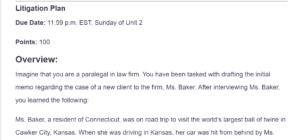Litigation Plan
Memorandum
To: Supervising Attorney
From: Your Name
CC: Other recipients
Subject: Litigation Plan
Greetings! This memo reviews a scenario where Ms. Smith’s car hit Ms. Baker’s car, resulting in damages of more than $75,000. MS. Baker lives in Connecticut, and Ms. Smith lives in Kansas.
This case can be filed in federal court because the scenario meets diversity jurisdiction requirements. One of the requirements is that the plaintiffs must be US citizens of a different state from the defendant (Weich, 2016; Dodson, 2021). The second requirement is that the amount in controversy must be more than $75,000 (Weich, 2016; Dodson, 2021).
The first document that the firm should file in court on behalf of Ms. Baker is a summon. The court orders a summon letter to notify the recipient that they have been sued, refers to the petition or complaint, and sets the timeframe within which the defendant is supposed to file an answer or ask the court to dismiss the case (Spencer & Spencer, 2016). The summon also describes the consequences of failure to respond on time; the court may decide the case without the defendant, and the defendant may be bound by the result even though they were not participating in the case.
The information that should be sought in discovery is whether there is a witness who saw the accident happening, anything any of the two parties said when the accident occurred, whether there was a dispute between the two parties and the identity of the witness.
One of the witnesses who should be called on behalf of Ms. Baker at trial is anyone who was in the car with Ms. Baker when the accident occurred. Another witness is any bystander who saw the accident happening. The third witness is one of the police officers who determined the accident was Ms. Smith’s fault.
ADR would be helpful in this case because the police already determined whose mistake it was. Therefore, the two parties can use ADR to come up with a solution to ensure that all damages are paid.
References
Dodson, S. (2021). In-state invocation of diversity jurisdiction: Theories. Academia Letters. https://doi.org/10.20935/al844
Spencer, M., & Spencer, J. (2016). 4. Character of defendant. Law Trove. https://doi.org/10.1093/he/9780198715795.003.0004
Weich, R. (2016). Exploring federal diversity jurisdiction. SSRN Electronic Journal. https://doi.org/10.2139/ssrn.2839446
ORDER A PLAGIARISM-FREE PAPER HERE
We’ll write everything from scratch
Question 
Litigation Plan
Due Date: 11:59 p.m. EST, Sunday of Unit 2

Litigation Plan
Points: 100
Overview:
Imagine that you are a paralegal in law firm. You have been tasked with drafting the initial memo regarding the case of a new client to the firm, Ms. Baker. After interviewing Ms. Baker, you learned the following:
Ms. Baker, a resident of Connecticut, was on road trip to visit the world’s largest ball of twine in Cawker City, Kansas. When she was driving in Kansas, her car was hit from behind by Ms. Smith, a Kansas resident. Unfortunately, Ms. Baker’s car was totaled, she suffered injuries, emotional distress and lost time from work. Her damages exceeded $75,000. The police determined the accident was wholly the faulty of Ms. Smith.
Instructions:
- Use the attached Memo
- Draft an office memorandum to your supervising attorney in which you answer the following questions:
- Can this case be filed in federal court? Why? (HINT: See Diversity Jurisdiction)
- Identify and explain the first document that the firm should file in court on behalf of Ms. Baker that will let Ms. Smith know that she is being
- Identify what information should be sought in
- Identify and explain witnesses that should be called on behalf of Baker at trial.
- Would ADR be helpful in this case? Why?
Requirements:
- Use APA format for non-legal sources such as the textbook. Use Bluebook citation format for any legal
- Submit a Word document using the Memo
- Maximum two pages in length, excluding the Reference
Be sure to read the criteria below by which your work will be evaluated before you write and again after you write.